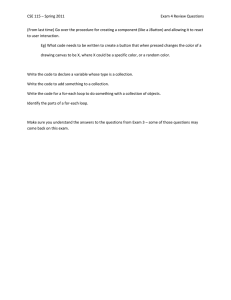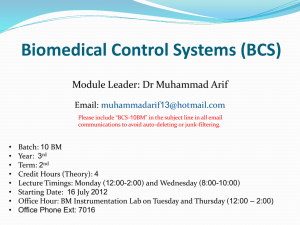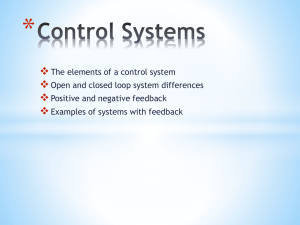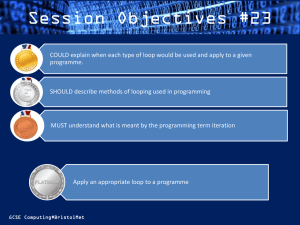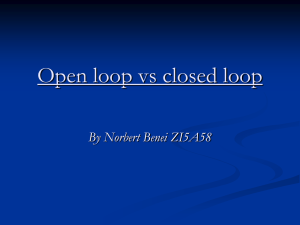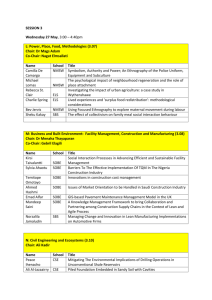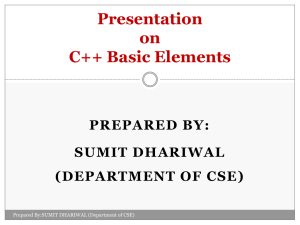Control Systems
advertisement
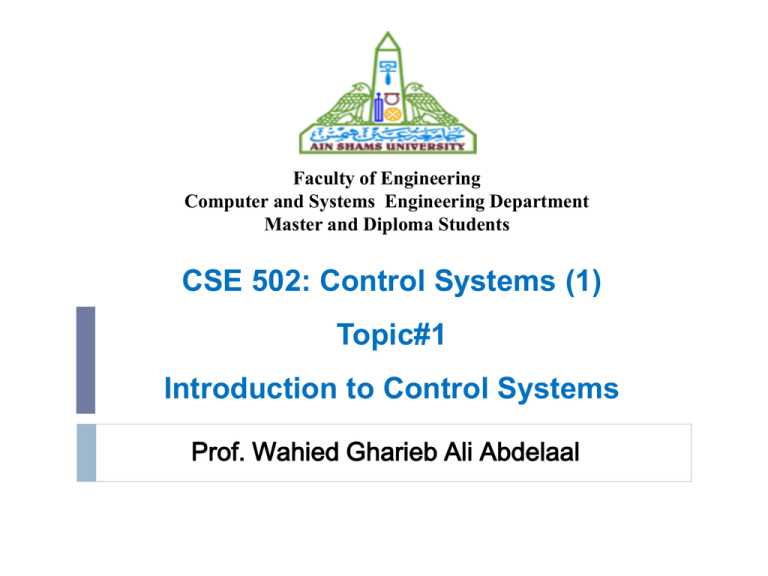
Faculty of Engineering Computer and Systems Engineering Department Master and Diploma Students CSE 502: Control Systems (1) Topic#1 Introduction to Control Systems Prof. Wahied Gharieb Ali Abdelaal CSE 502: Control Systems (1) Instructor: Prof. Wahied Gharieb Ali Office: R302 E-mail: wahid_ali@eng.asu.edu.eg - wahied@hotmail.com Lectures: http://portal.eng.asu.edu.eg/wahied TEXTBOOKS Part-1 Analog Control: Norman S. Nise, “Control Systems Engineering”, 6th Edition, John Wiley & Sons, 2011. 2) R. C. Dorf and R. H. Bishop, “Modern Control Systems”, 12th Edition, Prentice Hall, 2011. 3) K. Ogata, “Modern Control Engineering”, 5th Edition, Prentice Hall, 2010. 4) Farid Golnaraghi and Benjamin C. Kou, “Automatic Control Systems”, 9th Edition, John Willy & Sons, 2010. 1) 2 CSE 502: Control Systems (1) Part-2 Digital Control: 5) 6) 7) M. Sami Fadali and Antonio Visioli, “Digital Control Engineering: Analysis and Design”, Academic Press (Elsevier) 2nd edition, 2013. Edited by William S. Levine, “Control Systems Fundamentals”, CRC Press Taylor & Francis Group, Section IV – Digital Control, 2011. Ioan D. Landau and Gianluca Zito, “Digital Control Systems: Design, identification, and Implementation”, Springer-Verlag 2006. Additional Readings: Wikibooks, “Control Systems”, free download from http://en.wikibooks.org/wiki/Control_Systems , 2013. 9) Derek P. Atherton, “Control Engineering Problems with Solutions”, First edition, free download from www.bookboon.com , 2013. 10) Derek P. Atherton, “Control Engineering: An introduction with the use of Matlab”, Second edition, free download from www.bookboon.com, 2013. 8) 3 CSE 502: Control Systems (1) Course Grading Assignments (20) Individual work Micro Project (10) Team work (2 or 3) Final Exam (70) 4 CSE 502: Control Systems (1) Course Policies: 1. Assignments: should be submitted on the due date. 2. Late assignments: On time (100%), next day (90%), next 2 days (80%), next 3 days or more (0%). 3. Collaboration: You are encouraged to discuss the assigned problems/projects with your classmates. But you are not allowed to talk about the final solution itself or to show your solution to others. Every student has to prepare his/her solution independently. 4. Preparing the final solution: Please write your solution in a clear, readable, and concise form. Every answer should be fully justified. 5 Course Objectives Provide a background concepts in control engineering Study basic mathematical tools for analysis and design in control engineering such as Laplace transform, transfer function, block diagram, state space model, Z-transform, and stability analysis. Use the root-locus technique in the analysis of control systems Study the time domain analysis (State Space) and frequency domain (Nyquist plots, Bode plots) analysis tools. Design the industrial PID controllers to meet specific performance requirements Emphasize the use of MATLAB for analysis and design. 6 Course Outline Topic 1: Introduction to Control Systems Topic 2: Mathematical Tools for Analysis Topic 3: Representation and Sensitivity Analysis Topic 4: Dynamic models for linear systems Topic 5: Stability analysis Topic 6: Root locus techniques Topic 6: Time domain analysis (State Space Model) Topic 7: Frequency domain analysis ( Bode and Nyquist plots) Topic 8: Industrial control design (PID & RTS Regulators) Topic 9: Practical considerations in control design Topic 10: Embedded control systems Topic 11: SCADA and DCS Systems Topic 12: Recap 7 Introduction to Control Systems What is “a system”? System is composed of a set of interacting components (elements) stimulated or excited by an external input to produce an external output (System properties?). What is “ a control”? Control is a hidden technology in many applications to stabilize the system and to maintain its output close as possible to the desired value. 8 Introduction to Control Systems 9 Primal Dual Linear Nonlinear Continuous-Time Discrete Time Time Invariant Time Varying Deterministic Stochastic Static Dynamic Causal Non-Causal Single input Multi-input Introduction to Control Systems Input Signal Control System Output Signal Energy Source • Definition: The input is the stimulus, excitation, or command applied to a control system in order to produce a specified response from the control system. • Definition: The output is the actual response obtained from a control system. • Definition: The parameter is the value of a component in the system, such as mass, resistance, capacitor, … etc. • Definition: The variable is the measured signal, such as current, volt, force, position, …etc. 10 Applications 11 Applications 12 Applications Unmanned Ground Vehicles (UGV) 13 Applications Unmanned Aerial Vehicle (UAV) 14 Applications 15 Course Framework Analysis Control Design 16 Control Objectives Main Objectives: • Stability (Regulation) • Performance (Tracking: transient response and steady state response SMART Objectives: • Specific • Measurable • Achievable • Realistic • Timed 17 Physical Systems 18 Control Systems • Thermal control system • Flow control system • Level control system • Pressure control system • Speed control system • Position control system 19 Complex Interconnected Systems 20 Complex Interconnected Systems 21 Open-loop Control (Feed-Forward control) Program setting (Input) Laundry Machine Washed clothes (Output) A laundry machine washes clothes, by setting a program. It does not measure how clean the clothes become. Control without measuring devices (sensors) are called open-loop control. 22 Open-loop Control (Feed-Forward control) Application: CD player, computer disk drive Requirement: Constant speed of rotation Open loop control system: Block diagram representation: 23 Closed Loop (Feedback Control) Closed-loop control system: Block diagram representation: 24 Open loop and Closed loop 25 Open loop Closed loop Isolated systems Non-Isolated systems More faster Slower (time delay) Less cost More cost Time constant parameters More robust Car Control Car driving system Objective: To control direction and speed of a car Outputs: Actual direction and speed of car Control inputs: Road markings and speed signs Disturbances: Road surface and grade, wind, obstacles Possible subsystems: The car alone, power steering system, breaking system 26 Car Control Functional block diagram: Desired course of travel + Error - Driver Steering Mechanism Automobile Measurement, visual and tactile Time response: 27 Actual course of travel Car Control Controller + Actuator 28 Position Control Specification: Speed of disk: 1800 rpm to 7200 rpm Distance head-disk: Less than 100nm Position accuracy: 1 µm Move the head from track ‘a’ to track ‘b’ within 50ms 29 Level Control 30 Speed Control of Steam Engine 31 Human Body - )85 لا"( اإلسراء ْ " َو َما أُوتِي ُتمْ مِنْ العِل ِْم ْإِ ْلا َقلِي:قال هللا تعالى .) صدق هللا العظيم21 " َوفِي أَنفُسِ ُكمْ أَ َفل ُتبصِ ُرونَْ”( الذاريات Temperature Regulated temperature around 37°C Eyes Follow moving objects Hands Pick up an object and place it at a predetermined location Pancreas 32 Regulates glucose level in the blood Human Body Temperature Control System 33 Human Body Blood-Glucose Concentration 34 Human Body Open loop control (preprogrammed insulin pump) 35 Human Body Closed loop control (Artificial Pancreas) 36 Control Mechanisms 1) The aim is to maintain a physical variable at some fixed value in presence of disturbances, which is called process control. Example: temperature, level, pressure, flow, oil and gas industry. 37 Control Mechanisms 2) The second class is the Servo Control This is a control system in which a physical variable is required to follow (track) some desired time function. Example: position control of antennae , aircraft landing system, or a robot arm designed to follow a required path in space. 38 Control Mechanisms 3) Sequentially Controlled Systems A series of defined tasks to be performed. Time-Driven Each operation in the sequence is performed for a certain amount of time. May be open-loop control. Event-Drive: Each operation is performed until some event goal is reached. Must be closed-loop control. 39 Why Negative Feedback? Positive Feedback Wall 40 Wall Sensors and actuators in control systems 41 Sensors and actuators in control systems 42 Feedback Control 43 Feedback Control Actuation Decision Sensing Signaling Goals Stability: system maintains desired operating point Performance: system responds rapidly to the desired changes Robustness: system tolerates perturbations in dynamics and environment 44 Computer-Controlled Systems PLC SCADA 45 Computer-Controlled Systems Prosthetic care goes back to the fifth Egyptian Dynasty 46 Computer-Controlled Systems Brain Controlled Artificial Leg After losing his lower right leg in a motorcycle accident in 2009, 32-yearold Zac Vawter has been fitted with an artificial limb that uses neuro signals from his upper leg muscles to control the prosthetic knee and ankle. The motorized limb is the first thought controlled bionic leg, scientists at the Rehabilitation Institute of Chicago, reported in The New England Journal of Medicine. 47 Control Modes Manual control: The system is fully operated with human intervention. This control mode is usually used in the case of: new installation, maintenance, and complex operations (flight take off/landing). Automatic Control: The system is fully operated without human intervention. This mode is used in autonomous systems. Semi-Automatic Control: The system is operated with human intervention under automatic safety protection. 48 History of Automatic Control 49 History of Automatic Control 50 History of Automatic Control 51 History of Automatic Control 52 History of Automatic Control 53 History of Automatic Control 54 History of Automatic Control 55 Future of Control Systems 56 Journals in Control Engineering 57 THANK YOU FOR YOUR ATTENTION! wahid_ali@eng.asu.edu.eg 58
